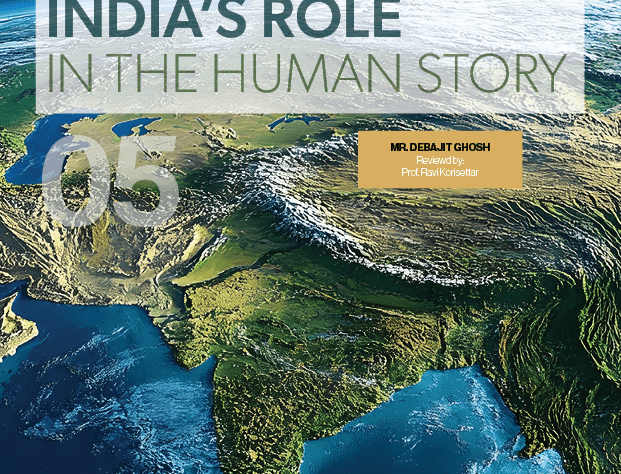INDIA’S ROLE
in the Human Story
Mr. Debajit Ghosh
Okay, everyone, let’s take a trip way back in time, over 1,40,000 years ago!

Ancient humans were present even 1,40,000 years ago in India. But their lives were very different from ours. They didn’t have cities, farms, or even permanent homes. There were no roads, houses or schools. They were hunter-gatherers, which means they travelled from place to place, collecting plants and hunting animals for food. They were like expert explorers, always on the move following places having food and water were available.
But why did they keep moving?
The Earth’s climate keep changing. In the past there were long extreme cold and dry times called glacial periods, Similarly, there were extended warm and wet times called interglacial periods The fluctuating climate result in change in regions of dominance of forests, available sources and quantity of water as well as the vegetation and animals inhabiting different regions with climate. When the environment changed, people had to move to places where climate is conducive as well as water and food is available for survival
Scientists believe that modern humans like us first lived in Africa. Africa is like a starting point of our journey. During warmer, greener periods, even deserts were easier to cross. These green stretches became ecological corridors as well as natural paths that helped people move out of Africa into new lands. This movement of people, looking for better places to live is called dispersal. This didn’t just happen once but multiple times as humans probably left Africa several times and continued their migration to new lands.
But how do we know this?
We don’t find many human skeletons from that long ago, especially in India. But we do find the something important which is associated with these primitive people. These are stone tools used by these people for hunting and other routine activities. These tools are found at places of their living, hunting and tell us about their survival skills in different environments.Different places and times had different types of tools.

In India, places like the Kurnool basin in Andra Pradesh are full of exciting discoveries related to primitive modern humans. In a cave called Billa Surgam, scientists found signs suggesting occupation by animals or people. Animals and maybe people lived there for as long as 200,000 years. Even when the climate changed, this place provided safe stay . These kinds of safe places are called refugia providing nature’s shelters during tough times.

So, what’s the big story here?
Climate change shaped where humans could live. During good times and favorable climate, they moved and explored new places. Even when things got hard, like during freezing cold periods, scorching hot weather or after a volcano eruption humans found ways to survive. They didn’t have sophisticated advanced technology similar to present day, but they had ability to make stone tools, read nature and make wise choices for survival. In India, we’ve found some incredible clues about how early people lived, moved, and adapted to a changing world. Whatever happened, humans have always been able to find a way forward. So, whenever you are amazed by climate change, just remember we come from a long line of survivors.



